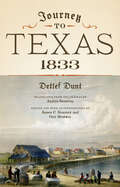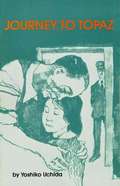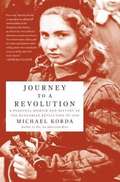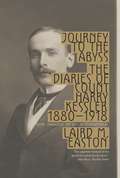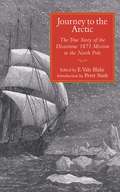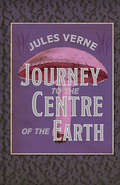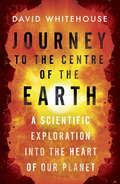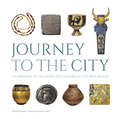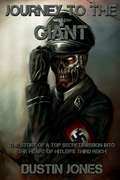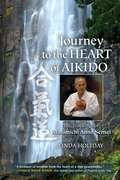- Table View
- List View
Journey to Texas, 1833
by Detlef DuntIn 1834, a German immigrant to Texas, D. T. F. (Detlef Thomas Friedrich) Jordt, aka Detlef Dunt, published Reise nach Texas, a delightful little book that praised Texas as “a land which puts riches in [the immigrant’s] lap, which can bring happiness to thousands and to their descendants.” Dunt’s volume was the first one written by an on-the-ground observer to encourage German immigration to Texas, and it provides an unparalleled portrait of Austin’s Colony from the lower Brazos region and San Felipe to the Industry and Frelsburg areas, where Dunt resided with Friedrich Ernst and his family. Journey to Texas, 1833 offers the first English translation of Reise nach Texas. It brings to vivid life the personalities, scenic landscapes, and customs that Dunt encountered in colonial Texas on the eve of revolution, along with his many practical suggestions for Germans who intended to emigrate. The editors’ introduction describes the social, political, and economic conditions that prompted Europeans to emigrate to Texas and provides biographical background on Dunt and his connection with Friedrich Ernst. Also included in the volume are a bibliography of German works about Texas and an interpretive essay discussing all of the early German literature about Texas and Dunt’s place within it. Expanding our knowledge of German immigration to Texas beyond the more fully documented Hill Country communities, Journey to Texas, 1833 also adds an important chapter to the story of pre-Revolutionary Texas by a sophisticated commentator.
Journey to Texas, 1833
by Detlef DuntIn 1834, a German immigrant to Texas, D. T. F. (Detlef Thomas Friedrich) Jordt, aka Detlef Dunt, published Reise nach Texas, a delightful little book that praised Texas as “a land which puts riches in [the immigrant’s] lap, which can bring happiness to thousands and to their descendants.” Dunt’s volume was the first one written by an on-the-ground observer to encourage German immigration to Texas, and it provides an unparalleled portrait of Austin’s Colony from the lower Brazos region and San Felipe to the Industry and Frelsburg areas, where Dunt resided with Friedrich Ernst and his family. Journey to Texas, 1833 offers the first English translation of Reise nach Texas. It brings to vivid life the personalities, scenic landscapes, and customs that Dunt encountered in colonial Texas on the eve of revolution, along with his many practical suggestions for Germans who intended to emigrate. The editors’ introduction describes the social, political, and economic conditions that prompted Europeans to emigrate to Texas and provides biographical background on Dunt and his connection with Friedrich Ernst. Also included in the volume are a bibliography of German works about Texas and an interpretive essay discussing all of the early German literature about Texas and Dunt’s place within it. Expanding our knowledge of German immigration to Texas beyond the more fully documented Hill Country communities, Journey to Texas, 1833 also adds an important chapter to the story of pre-Revolutionary Texas by a sophisticated commentator.
Journey to Topaz (50th Anniversary Edition)
by Yoshiko UchidaCelebrating the 50th anniversary of a landmark work of juvenile fiction This much-loved and widely read classic is the moving story of one girl’s struggle to remain brave during the World War II incarceration of Japanese Americans. In 1941, eleven-year-old Yuki is looking forward to Christmas when disaster strikes: she and her family, along with everyone of Japanese descent on the West Coast, are labeled enemy aliens. The FBI arrests her father, and she, her mother, and her brother are imprisoned in a bleak and dusty camp surrounded by barbed wire in the Utah desert. There, she and her family experience both true friendship and heart-wrenching tragedy. Journey to Topaz explores the consequences of prejudice and the capacities of the human spirit. First published in 1971, this novel was the first children’s book about the wartime incarceration written by a Japanese American. This fiftieth anniversary edition features new cover art, a refreshed design, and a new foreword by Traci Chee.
Journey to Topaz: A Story of Japanese-American Evacuation
by Yoshiko UchidaAfter the bombing of Pearl Harbor, 11-year-old Yuki Sakane's family is uprooted and shipped with thousands of other West Coast Japanese-Americans to the horse stalls of Tanforan Racetrack and then to a bleak desert concentration camp called Topaz.
Journey to Yesterday
by June Lund ShiplettA TWENTIETH-CENTURY WOMAN ON A NINETEENTH-CENTURY ODYSSEY OF PASSION AND DANGER! The men at the party couldn't take their eyes off Stacey as the stunning redhead jackknifed into the swimming pool. But suddenly, mysteriously, she was gone, torn from her husband and daughters in Cleveland and thrust into the untamed pioneer days of America's past. Frightened and bewildered at first, Stacey felt safer when she became governess to handsome Ben Clayton's two motherless children. When he proposed to make the perilous journey out West by covered wagon, she agreed to go. But Stacey didn't know the depth of her desire for Ben, nor the savage excitement that awaited her. Would she ever return to her safe and comfortable life in the twentieth century? Or did her destiny now lie in the past with a love as strong and powerful as the one she left behind?
Journey to a Revolution
by Michael KordaThe Hungarian Revolution of 1956 was perhaps the most dramatic single event of the Cold War and a major turning point in history. Though it ended unsuccessfully, the spontaneous uprising of Hungarians against their country's Communist party and the Soviet occupation forces in the wake of Stalin's death demonstrated to the world at large the failure of Communism. In full view of the Western media--and therefore the world--the Russians were obliged to use force on a vast scale to subdue armed students, factory workers, and intellectuals in the streets of a major European capital.In October 1956, Michael Korda and three fellow Oxford undergraduates traveled to Budapest in a beat-up Volkswagen to bring badly needed medicine to the hospitals--and to participate, at street level, in one of the great battles of the postwar era. Journey to a Revolution is at once history and a compelling memoir--the author's riveting account of the course of the revolution, from its heroic beginnings to the sad martyrdom of its end.end.
Journey to a Revolution: A Personal Memoir and the History of the Hungarian Revolution of 1956
by Michael KordaThe Hungarian Revolution of 1956 was perhaps the most dramatic single event of the Cold War and a major turning point in history. Though it ended unsuccessfully, the spontaneous uprising of Hungarians against their country's Communist party and the Soviet occupation forces in the wake of Stalin's death demonstrated to the world at large the failure of Communism. In full view of the Western media--and therefore the world--the Russians were obliged to use force on a vast scale to subdue armed students, factory workers, and intellectuals in the streets of a major European capital. In October 1956, Michael Korda and three fellow Oxford undergraduates traveled to Budapest in a beat-up Volkswagen to bring badly needed medicine to the hospitals--and to participate, at street level, in one of the great battles of the postwar era. Journey to a Revolution is at once history and a compelling memoir--the author's riveting account of the course of the revolution, from its heroic beginnings to the sad martyrdom of its end.
Journey to the Abyss: The Diaries of Count Harry Kessler, 1880-1918
by Harry Kessler Laird EastonThese fascinating, never-before-published early diaries of Count Harry Kessler--patron, museum director, publisher, cultural critic, soldier, secret agent, and diplomat--present a sweeping panorama of the arts and politics of Belle Époque Europe, a glittering world poised to be changed irrevocably by the Great War. Kessler's immersion in the new art and literature of Paris, London, and Berlin unfolds in the first part of the diaries. This refined world gives way to vivid descriptions of the horrific fighting on the Eastern and Western fronts of World War I, the intriguing private discussions among the German political and military elite about the progress of the war, as well as Kessler's account of his role as a diplomat with a secret mission in Switzerland. Profoundly modern and often prescient, Kessler was an erudite cultural impresario and catalyst who as a cofounder of the avant-garde journal Pan met and contributed articles about many of the leading artists and writers of the day. In 1903 he became director of the Grand Ducal Museum of Arts and Crafts in Weimar, determined to make it a center of aesthetic modernism together with his friend the architect Henry van de Velde, whose school of design would eventually become the Bauhaus. When a public scandal forced his resignation in 1906, Kessler turned to other projects, including collaborating with the Austrian writer Hugo von Hofmannsthal and the German composer Richard Strauss on the opera Der Rosenkavalier and the ballet The Legend of Joseph, which was performed in 1914 by the Ballets Russes in London and Paris. In 1913 he founded the Cranach-Presse in Weimar, one of the most important private presses of the twentieth century. The diaries present brilliant, sharply etched, and often richly comical descriptions of his encounters, conversations, and creative collaborations with some of the most celebrated people of his time: Otto von Bismarck, Paul von Hindenburg, Hugo von Hofmannsthal, Richard Strauss, Igor Stravinsky, Sergei Diaghilev, Vaslav Nijinsky, Isadora Duncan, Ruth St. Denis, Sarah Bernhardt, Friedrich Nietzsche, Rainer Marie Rilke, Paul Verlaine, Gordon Craig, George Bernard Shaw, Harley Granville-Barker, Max Klinger, Arnold Böcklin, Max Beckmann, Aristide Maillol, Auguste Rodin, Edgar Degas, Éduard Vuillard, Claude Monet, Edvard Munch, Ida Rubinstein, Gabriele D'Annunzio, Pierre Bonnard, and Walther Rathenau, among others. Remarkably insightful, poignant, and cinematic in their scope, Kessler's diaries are an invaluable record of one of the most volatile and seminal moments in modern Western history.From the Hardcover edition.
Journey to the Arctic: The True Story of the Disastrous 1871 Mission to the North Pole
by Peter Stark Euphemia Vale Blake“While floating down on the ice-floe, in the midst of dirt and darkness, hungry and cold… I wondered at myself that I could have learned, in a few short months, to have eaten such things, and submitted to such practices, as but few civilized persons have ever been called to endure.”In June of 1871, navigator George E. Tyson and the Polaris sailed forth from New York to pursue an American dream—to be the first expedition to explore the icy waters of the North Pole. Led by Captain Hall, veteran Arctic explorer, and funded with a $50,000 grant from the U.S. Congress, it seemed the Polaris would not fail. But the voyage was doomed from the start: impassable ice-floes, a crew that couldn’t get along, and eventually the poisoning and untimely death of Captain Hall. Finally, as winter approached, Tyson and half the crew found themselves stranded on the Arctic ice, incapable of reconnecting with their ship. They would not be rescued for six months. Through Tyson’s detailed notes and a journal written upon the ice, Journey to the Arctic tells the harrowing tale of survival, slow starvation, and of men turned wild in frigid climes.This definitive edition includes original engravings of the explorers and their findings, charts and maps of their journey, and a new introduction by famed adventure essayist and Arctic exploration expert Peter Stark.
Journey to the Bottomless Pit: The Story of Stephen Bishop & Mammoth Cave
by Elizabeth Mitchell“A fascinating story.” —LeVar BurtonThe thrilling adventures of a slave who became known worldwide for his explorations of Mammoth Cave. If you toured Mammoth Cave in Kentucky in the year 1838, you would have been led by candlelight through dark, winding tunnels to the edge of a terrifying bottomless pit. Your guide would have been seventeen-year-old Stephen Bishop, an African American slave who became known around the world for his knowledge of Mammoth Cave. Bishop needed bravery, intelligence, and curiosity to explore the vast cavern. Using only a lantern, rope, and other basic caving equipment, he found a way to cross the bottomless pit and discover many more miles of incredible grottoes and tunnels. For the rest of his life he guided visitors through the cave, showing them how to stoop, bend, and crawl through passageways that were sometimes far from the traditional tour route. Based on the narratives of those who toured the cave with him, Journey to the Bottomless Pit is the first book for young readers ever written about Stephen Bishop.
Journey to the Centre of the Earth (Classics With Ruskin Series #Vol. 4)
by Jules VerneOriginally published in 1864, this classic science fiction novel is simultaneously a perilous adventure into the earth’s core and a reflection on the perfectibility of human understanding and psychology of explorers. The intrepid Professor Lidenbrock and his nervous nephew Axel decode a scrap of paper written in runic script and embark on the strangest expedition of the nineteenth century. Enlisting the silent Hans as their guide, they travel across Iceland to find the secret passage to the centre of the earth via an extinct volcano, finding in it an astonishing subterranean menagerie of natural hazards, prehistoric beasts and sea monsters, and curious sights. Penguin Random House Canada is proud to bring you classic works of literature in e-book form, with the highest quality production values. Find more today and rediscover books you never knew you loved.
Journey to the Centre of the Earth: The Remarkable Voyage of Scientific Discovery into the Heart of Our World
by David WhitehouseThe journey to the centre of the earth is a voyage like no other we can imagine.Over 3,000 km below the earth's surface an extraordinary inner world the size of Mars awaits us.Dive through the molten iron of the outer core and eventually you will reach a solid sphere - an iron-clad world held within a metal sea and unattached to anything above.At the earth's core is the history of our planet written in temperature and pressure, crystals and minerals . . . Our planet appears tranquil from outer space. And yet the arcs of volcanoes, the earthquake zones and the auroral glow rippling above our heads are testimony to something remarkable happening inside . . .For thousands of years these phenomena were explained in legend and myth. Only in recent times has the brave new science of seismology emerged. One hundred and fifty years after the extraordinary, imaginative feat of Jules Verne's JOURNEY TO THE CENTRE OF THE EARTH, David Whitehouse embarks on a voyage of scientific discovery into the heart of our world.
Journey to the Centre of the Earth: The Remarkable Voyage of Scientific Discovery into the Heart of Our World
by Dr David WhitehouseThe journey to the centre of the earth is a voyage like no other we can imagine.Over 3,000 km below the earth's surface an extraordinary inner world the size of Mars awaits us.Dive through the molten iron of the outer core and eventually you will reach a solid sphere - an iron-clad world held within a metal sea and unattached to anything above.At the earth's core is the history of our planet written in temperature and pressure, crystals and minerals . . . Our planet appears tranquil from outer space. And yet the arcs of volcanoes, the earthquake zones and the auroral glow rippling above our heads are testimony to something remarkable happening inside . . .For thousands of years these phenomena were explained in legend and myth. Only in recent times has the brave new science of seismology emerged. One hundred and fifty years after the extraordinary, imaginative feat of Jules Verne's JOURNEY TO THE CENTRE OF THE EARTH, David Whitehouse embarks on a voyage of scientific discovery into the heart of our world.
Journey to the City: A Companion to the Middle East Galleries at the Penn Museum
by Steve Tinney Karen SonikThe Penn Museum has a long and storied history of research and archaeological exploration in the ancient Middle East. This book highlights this rich depth of knowledge while also serving as a companion volume to the Museum's signature Middle East Galleries opening in April 2018. This edited volume includes chapters and integrated short, focused pieces from Museum curators and staff actively involved in the detailed planning of the new galleries. In addition to highlighting the most remarkable and interesting objects in the Museum's extraordinary Middle East collections, this volume illuminates the primary themes within these galleries (make, settle, connect, organize, and believe) and provides a larger context within which to understand them.The ancient Middle East is home to the first urban settlements in human history, dating to the fourth millennium BCE; therefore, tracing this move toward city life figures prominently in the book. The topic of urbanization, how it came about and how these early steps still impact our daily lives, is explored from regional and localized perspectives, bringing us from Mesopotamia (Ur, Uruk, and Nippur) to Islamic and Persianate cites (Rayy and Isfahan) and, finally, connecting back to life in modern Philadelphia. Through examination of topics such as landscape, resources, trade, religious belief and burial practices, daily life, and nomads, this very important human journey is investigated both broadly and with specific case studies.
Journey to the East: The Jesuit Mission to China, 1579-1724
by Liam Matthew BrockeyIt was one of the great encounters of world history: highly educated European priests confronting Chinese culture for the first time in the modern era. This “journey to the East” is explored by Liam Brockey as he retraces the path of the Jesuit missionaries who sailed from Portugal to China, believing that, with little more than firm conviction and divine assistance, they could convert the Chinese to Christianity. Moving beyond the image of Jesuits as cultural emissaries, his book shows how these priests, in the first concerted European effort to engage with Chinese language and thought, translated Roman Catholicism into the Chinese cultural frame and eventually claimed two hundred thousand converts. The first narrative history of the Jesuits’ mission from 1579 until the proscription of Christianity in China in 1724, this study is also the first to use extensive documentation of the enterprise found in Lisbon and Rome. The peril of travel in the premodern world, the danger of entering a foreign land alone and unarmed, and the challenge of understanding a radically different culture result in episodes of high drama set against such backdrops as the imperial court of Peking, the villages of Shanxi Province, and the bustling cities of the Yangzi Delta region. Further scenes show how the Jesuits claimed conversions and molded their Christian communities into outposts of Baroque Catholicism in the vastness of China. In the retelling, this story reaches across continents and centuries to reveal the deep political, cultural, scientific, linguistic, and religious complexities of a true early engagement between East and West.
Journey to the Giant: The Story of a Top Secret Mission Into the Heart of Hitler's Third Reich
by Dustin JonesIn the year 1944, as World War Two rages onward in Europe a squad of highly trained and skilled soldiers from the United States Army embark on a covert mission to dismantle Hitler's most secretive and sinister of experiments. As the group of men travel to Hitler's secluded underground facility, dubbed Der Riese or 'The Giant', will they have what it takes to stop Germany's dictator once and for all, or will they succumb to the dangers of the undead, ravenous blitz wolves, and savage mutated soldiers? Follow the harrowing adventures of Sergeant James Jacobs, Joseph Doc Wolfwood, Privates Kevin Killian, Jonathan Flynn, Jack Evans, Stephen Quinn, Teddy Stacy, and Greg Walter as they race to save the lives of millions, and history itself in this action packed story of war, friendship, treachery, and the will to survive.
Journey to the Heart of Aikido: The Teachings of Motomichi Anno Sensei
by Linda Holiday Motomichi AnnoJourney to the Heart of Aikido presents the teachings of Motomichi Anno Sensei, one of the few remaining direct students of Morihei Ueshiba, the legendary founder of Aikido. After a lifetime of practice and teaching in Japan, the United States, and Europe, Anno Sensei conveys through his teachings Aikido's essential spirit of love, harmony, gratitude, and purification with simple authenticity and eloquence. Author and translator Linda Holiday--herself a senior instructor of Aikido--brings to life the intimacy of this communication through translated discourses on the deep practice of Aikido and candid dialogues between Anno sensei and Western students. Journey to the Heart of Aikido includes Linda Holiday's vivid account of her adventure as a young woman studying Aikido in the mystical region of Kumano, Japan, in the 1970s, and a poignant telling of Anno sensei's life and his first-hand experience of training with Aikido's founder. An essential resource for the global Aikido community, Journey to the Heart of Aikido also offers spiritual teachings relevant to all contemporary seekers, touching a wide range of themes such as the meaning of martial arts, the integration of body and spirit, the truth of interconnectedness, and the practice of peace, offering all readers insight into the profound spiritual questions at the heart of life.From the Trade Paperback edition.
Journey to the Maghreb and Andalusia, 1832: The Travel Notebooks and Other Writings
by Eugène DelacroixIn 1832, Eugène Delacroix accompanied a French diplomatic mission to Morocco, the first leg of a journey through the Maghreb and Andalusia that left an indelible impression on the painter. This comprehensive, annotated English-language translation of his notes and essays about this formative trip makes available a classic example of travel writing about the "Orient" from the era and provides a unique picture of the region against the backdrop of the French conquest of Algeria.Delacroix’s travels in Morocco, Algeria, and southern Spain led him to discover a culture about which he had held only imperfect and stereotypical ideas and provided a rich store of images that fed his imagination forever after. He wrote extensively about these experiences in several stunningly beautiful notebooks, noting the places he visited, routes he followed, scenes he observed, and people he encountered. Later, Delacroix wrote two articles about the trip, "A Jewish Wedding in Morocco" and the recently discovered "Memories of a Visit to Morocco," in which he shared these extraordinary experiences, revealing how deeply influential the trip was to his art and career. Never before translated into English, Journey to the Maghreb and Andalusia, 1832 includes Delacroix’s two articles, four previously known travel notebooks, fragments of two additional, recently discovered notebooks, and numerous notes and drafts. Michèle Hannoosh supplements these with an insightful introduction, full critical notes, appendices, and biographies, creating an essential volume for scholars and readers interested in Delacroix, French art history, Northern Africa, and nineteenth-century travel and culture.
Journey to the Maghreb and Andalusia, 1832: The Travel Notebooks and Other Writings
by Eugène DelacroixIn 1832, Eugène Delacroix accompanied a French diplomatic mission to Morocco, the first leg of a journey through the Maghreb and Andalusia that left an indelible impression on the painter. This comprehensive, annotated English-language translation of his notes and essays about this formative trip makes available a classic example of travel writing about the “Orient” from the era and provides a unique picture of the region against the backdrop of the French conquest of Algeria.Delacroix’s travels in Morocco, Algeria, and southern Spain led him to discover a culture about which he had held only imperfect and stereotypical ideas and provided a rich store of images that fed his imagination forever after. He wrote extensively about these experiences in several stunningly beautiful notebooks, noting the places he visited, routes he followed, scenes he observed, and people he encountered. Later, Delacroix wrote two articles about the trip, “A Jewish Wedding in Morocco” and the recently discovered “Memories of a Visit to Morocco,” in which he shared these extraordinary experiences, revealing how deeply influential the trip was to his art and career. Never before translated into English, Journey to the Maghreb and Andalusia, 1832 includes Delacroix’s two articles, four previously known travel notebooks, fragments of two additional, recently discovered notebooks, and numerous notes and drafts. Michèle Hannoosh supplements these with an insightful introduction, full critical notes, appendices, and biographies, creating an essential volume for scholars and readers interested in Delacroix, French art history, Northern Africa, and nineteenth-century travel and culture.
Journey to the Sacred Mountains
by Flynn JohnsonWeaving together three wisdom traditions-Native American spirituality, depth psychology, and Buddhism-into a profound understanding of the soul's journey, this resource offers vision quests and other nature-based experiences as a way to reestablish an intimate connection with the earth, humankind's original home. The knowledge and beauty of an ancient Sioux story, which serves as the guiding thread of the book, teaches the value of setting out on a quest in the natural world to discover who and what one truly is, while notions of a Buddhist path illustrate how to free oneself from constraining beliefs and conditioning. Seeking to explore the core center of any spiritual quest-a direct, unmediated experience of the sacred-rather than ascribe to one religion or dogma, this inspiring guide is a timely voice that advocates an equitable, sustainable way of living on the earth.
Journey to the Sun: Junipero Serra's Dream and the Founding of California
by Gregory OrfaleaThe fascinating narrative of the remarkable life of Junípero Serra, the intrepid priest who led Spain and the Catholic Church into California in the 1700s and became a key figure in the making of the American West.The fascinating narrative of the remarkable life of Junípero Serra, the intrepid priest who led Spain and the Catholic Church into California in the 1700s and became a key figure in the making of the American West In the year 1749, at the age of thirty-six, Junípero Serra left his position as a highly regarded priest in Spain for the turbulent and dangerous New World, knowing he would never return. The Spanish Crown and the Catholic Church both sought expansion in Mexico—the former in search of gold, the latter seeking souls—as well as entry into the mysterious land to the north called “California.” Serra’s mission: to spread Christianity in this unknown world by building churches wherever possible and by converting the native peoples to the Word of God. It was an undertaking that seemed impossible, given the vast distances, the challenges of the unforgiving landscape, and the danger posed by resistant native tribes. Such a journey would require bottomless physical stamina, indomitable psychic strength, and, above all, the deepest faith. Serra, a diminutive man with a stout heart, possessed all of these attributes, as well as an innate humility that allowed him to see the humanity in native people whom the West viewed as savages. By his death at age seventy-one, Serra had traveled more than 14,000 miles on land and sea through the New World—much of that distance on a chronically infected and painful foot—baptized and confirmed 6,000 Indians, and founded nine of California’s twenty-one missions, with his followers establishing the rest. The names of these missions ring through the history of California— San Diego, San Jose, San Juan Capistrano, Santa Clara, and San Francisco—and served as the epicenters of the arrival of Western civilization, where millions more would follow, creating the California we know today. An impoverished son, an inspired priest, and a potent political force, Serra was a complex man who stood at the historic crossroads between Native Americans, the often brutal Spanish soldiers, and the dictates of the Catholic Church, which still practiced punishment by flogging. In this uncertain, violent atmosphere, Serra sought to protect the indigenous peoples from abuse and to bring them the rituals and spiritual comfort of the Church even as the microbes carried by Europeans threatened their existence. Beginning with Serra’s boyhood on the isolated island of Mallorca, venturing into the final days of the Spanish Inquisition, revealing the thriving grandeur of Mexico City, and finally journeying up the untouched California coast, Gregory Orfalea’s magisterial biography is a rich epic that cuts new ground in our understanding of the origins of the United States. Combining biography, European history, knowledge of Catholic doctrine, and anthropology, Journey to the Sun brings original research and perspective to America’s creation story. Orfalea’s poetic and incisive recounting of Serra’s life shows how one man changed the future of California and in so doing affected the future of our nation.
Journey's End (Penguin Modern Classics)
by R. C. SherriffSet in the First World War, Journey's End concerns a group of British officers on the front line and opens in a dugout in the trenches in France. Raleigh, a new eighteen-year-old officer fresh out of English public school, joins the besieged company of his friend and cricketing hero Stanhope, and finds him dramatically changed ...Laurence Olivier starred as Stanhope in the first performance of Journey's End in 1928; the play was an instant stage success and remains a remarkable anti-war classic.
Journey's End: Bomber Command's Battle from Arnhem to Dresden and Beyond
by Kevin WilsonThe final, climactic volume of Wilson's acclaimed bomber war trilogy. In February 1945, British and American bombers rained down thousands of tons of incendiaries on the city of Dresden, creating one of the greatest firestorms in history. Their bombs killed an estimated 25,000 people, and wiped one of the most beautiful cities in Europe from the map. The controversy that erupted shortly afterwards, and which continues to this day, has long overshadowed the other events of the bomber war, and blighted the memory of the young men who gave their lives to fight in the skies over Germany.This book neither condemns the bombing of Dresden, nor excuses it, but simply puts it in its proper context as a devastating set of raids in a much larger campaign. To the crews who flew over Germany night after night there were other much more pressing worries: the V2 rockets that threatened their loved ones at home, the brand new German jet fighters that could strike them at speeds of over 600mph, the deadly flak over the cities of the Ruhr Valley. The bomber war had entered its final unforgiving months, and no quarter was given on either side. Kevin Wilson has interviewed over a hundred people for this book, some of whom flew on the Dresden raids, and many more who experienced other aspects of bombing, both in the air and on the ground. JOURNEY'S END chronicles the brutal endgame of a conflict that caused devastation and tragedy on both sides.
Journey's End: Bomber Command's Battle from Arnhem to Dresden and Beyond
by Kevin Wilson'A brilliant insight into life in the air and on the ground' ObserverIn February 1945, British and American bombers rained down thousands of tons of incendiaries on the city of Dresden, killing an estimated 25,000 people and destroying one of the most beautiful cities in Europe. The controversy that erupted shortly afterwards, and which continues to this day, has long overshadowed the other events of the bomber war, and blighted the memory of the young men who gave their lives to fight in the skies over Germany.Journey's End neither condemns nor condones the bombing of Dresden, but puts it in its proper context as part of a much larger campaign. To the young men who flew over Germany night after night there were other much more pressing worries: the V2 rockets that threatened their loved ones at home; the brand new German jet fighters that could strike them at speeds of over 600mph. They lived life at a heightened tempo during these final unforgiving months of the bomber war when no quarter was given on either side.As the climactic volume in Kevin Wilson's acclaimed bomber war trilogy, Journey's End chronicles the brutal endgame of a conflict that caused such devastation and tragedy on both sides.
Journey: A Western
by Stephen H. ForemanSet in the early eighteen hundreds in the wild desert wilderness of New Mexico Territory, Journey follows the lives of three distinctly different characters whose destinies are one: Journey, a fiercely independent, sixteen-year-old of mysterious origins; Reuben Moon, the stoic half Mexican, half Apache hunter who raises her; and Esau Burdock, a brutal, pragmatic, and wealthy slave trader.The story opens on a November night in 1833, the sky on fire with meteors, each character alone, experiencing the storm. The narrative then delves into their individual histories. But Journey, Reuben, and Esau’s stories soon collide in the summer of 1834 when Esau holds a rendezvous of horse racing and trading. Despite being only sixteen, and a girl at that, Journey joins the race. She doesn’t win, but she’s caught the attention of Esau. A year later, a mountain lion is terrorizing the area and Esau comes across Journey and Reuben in the desert as he hunts for it. Journey has tamed a wild colt. The lion had killed its mother then attacked the colt, but Journey rescues it and nurses it back to health. Esau claims the colt is his by the law of the land. Journey refuses to give him up and so Esau threatens to hang her on the spot. Instead, they make a deal: Journey can work at Esau’s stables for six months to earn the horse.And so she does. All the while the mountain lion continues to kill and Esau broods. He is a successful man, but he is a lonely one too, haunted by the death of his first slave and lover, Livy, and by their daughter Lilly Rose, both of whom betrayed him and are now dead. The story comes to a fever pitch when Esau spots a necklace Journey has worn her whole life, given to her by her mother, a necklace once worn by Esau’s dead daughter, Lily Rose. From there, the story races to an end, as Esau, Journey, and Reuben are tested in ways they never dreamed imaginable. Brimming with action and panoramic in scope, in Journey Foreman provides a breathtaking narrative with a heroine you’ll never forget.
